Chris Hedges's Blog, page 548
June 24, 2018
Korean Voices Missing From Major Papers’ Opinions on Singapore Summit
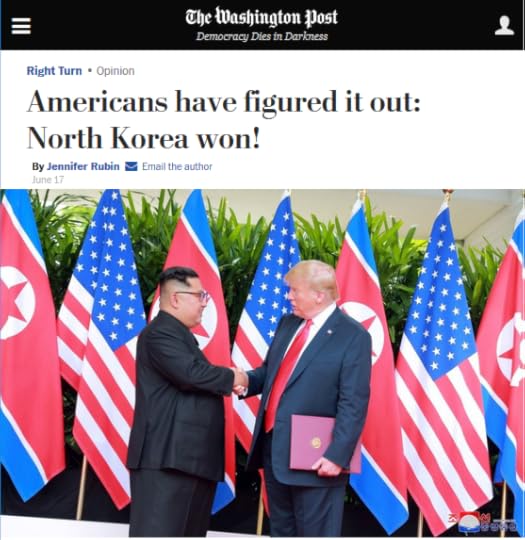
The Washington Post‘s Jennifer Rubin (6/17/18) epitomized the zero-sum takes of US pundits.
In major-paper opinion coverage of the Singapore summit, the people with the most to lose and gain from the summit, the people whose nation was actually being discussed—Koreans—were almost uniformly ignored.
Three major US papers—the New York Times,Washington Post and Wall Street Journal—had only one Korean-authored op-ed out of 41 opinion pieces on the subject of the Korean peace talks.
The Post had 23 total opinion pieces, the Times had 16 and the Journal four. The only op-ed by a Korean was a pro-summit piece on June 12 by Moon Chung-in, an aide to South Korean President Moon Jae-in. Of the 41 editorials or op-eds only four (9 percent), were broadly positive about the Trump/Kim summit, 29 (70 percent) were negative and eight (21 percent) were mixed or ambiguous. The full list, current as of June 19, is here.
As FAIR noted in May (5/7/18), there’s a huge chasm between how recent peace efforts are being received in ostensible US ally South Korea and how they’re being covered in US media. As we noted at the time, polling shows 88 percent of South Koreans in favor of these efforts, while the person spearheading them, President Moon, holds an 86 percent approval rating. But the bulk of US coverage ranged from snide dismissal to outright opposition (FAIR.org, 6/14/18).
Similarly, a poll taken after the Singapore summit found that 66 percent of South Koreans were pleased with the results, and only 11 percent opposed them. This contrasts sharply with the reaction in US newspapers, which has been overwhelmingly negative in tone, and dominated by NatSec-centered horse race takes over who “won.”
The New York Times published one pro-summit piece, by Victor Cha (6/12/18), and it was a very qualified and conflicted. The Washington Post was mostly negative and skeptical, with three exceptions: predictable partisan cheerleading from reliable Trump apologist Marc Thiessen (6/15/17); a measured “wait and see” take from Michael O’Hanlon, a fellow at the Brookings Institution (6/13/18); and the aforementioned piece by President Moon’s aide. The Wall Street Journal’s commentary was uniformly negative.
The US media’s reaction to the summit is almost a mirror image of that of the South Korean public: 70 percent of major US papers’ opinion columns disapproved of the summit, whereas 66 percent of South Koreans approved. Eleven percent of South Koreans disapproved, whereas only 9 percent of professional opinion-havers at the Times, Post and Journal thought the summit was a good thing.
This raises an important question: Why? What do US pundits know that those with something actually at stake—Koreans—don’t know?

Trump showed “reckless disregard for the security concerns of America’s allies,” argued Kori Schake of the International Institute for Strategic Studies, which is funded by Boeing, Northrop Grumman and Lockheed Martin (New York Times, 6/15/18)
One factor is that our media system turns to professional “experts” at a small handful of establishment think tanks, and these are often funded by monied interests with a vested interest in particular kinds of policy (Extra!, 7/13). On international questions, this often means the arms industry, who are major funders of think tanks like the Center for Strategic and International Studies (CSIS) and the International Institute for Strategic Studies (IISS). These think tanks produced predictably hawkish putdowns of the summit, such as CSIS’s Sue Mi Terry, who told MSNBC’s Nicolle Wallace, in a rare moment of candor:
A peace treaty is not OK. That should come at the end of the process, because a peace treaty, while it sounds great and could be historic, also undermines the justification of our troops staying South Korea.
The “justification” for troops also happens to be the justification for the weapons systems they come with, namely those of CSIS’s major donors Northrop Grumman, Lockheed Martin and Boeing (FAIR.org, 5/8/17).
Another part of the problem is partisanship. US pundits overwhelmingly view the Kim/Trump summit as a Trump-led or US-directed event, rather than an essential but limited part of a broader peace effort being undertaken by the Koreas themselves. This means the majority of the coverage is based on whether or not the US “won” or “advanced its interests,” not what’s good for the actual people who actually live on the Korean peninsula.
This is an understandable impulse. As Trump increasingly threatened immigrants, citizens of US war zones and a whole host of vulnerable populations, the instinct to oppose anything connected to him is excusable. But in the case of Korea, where Trump is simply one part of a broader peace strategy pursued by and for Koreans, this has led to a dangerous habit of trying to outflank Trump on the right. This is often achieved through traditionally right-wing tactics, like calling him “weak,” saying he’s “giving away too much” or some other such chest-pounding bromide.

The New Yorker (6/12/18) ran a rare piece on the summit from South Korea’s point of view.
As FAIR noted last week (6/14/18), MSNBC’s most popular liberal commentator, Rachel Maddow even cooked up a theory that this was all to help the bogeyman of Russia, because that country shares a small land border with North Korea.
Occasionally, some perspectives from Korea got through in US media, like a piece by E. Tammy Kim in the New Yorker (6/12/18) that relayed South Korea’s general sense of cautious optimism, a mood mostly reflected in opinion polls:
South Koreans do not trust Kim or Trump, or believe in the possibility of a quick reunification. They are simply aware of the toll that 70 years of national division have taken, and are eager for an alternative future.
It would be useful for major curators of opinion in the United States—whose military personnel still total 36,000 on the peninsula—to every now and then reach out to those affected by our foreign policy, rather than limiting the scope of debate to partisan pot shots and zero-sum takes. There’s a measurable, massive distance between how these peace efforts are received in South Korea versus how they’re covered stateside.
Perhaps editors and producers in major US media, instead of booking Max Boot or commissioning another arms industry-funded think tank mercenary for the 145,090th time, should ask themselves why that is, and who is served by it.

Soccer and Sausages: The World Cup’s Inflated Carbon Budget
With the World Cup underway in Russia, it’s sausages that are preoccupying one group of researchers, not soccer. They want to know how many sausages are eaten at the matches and what the resulting impact on the climate will be.
The study, by nu3, a German company specialising in nutrition and food supplements, says that at each World Cup match nearly 25,000 sausages will be swallowed by spectators.
As a result of the consumption of all those sausages – and their production – more than 3,000 kg of climate-changing carbon dioxide will be produced at every game played in Russia, says the study.
Its findings are a follow-on from nu3’s larger study, the Food Carbon Footprint Index, published earlier this year, which compares carbon dioxide emissions for 130 countries worldwide based on dietary habits.
By determining the average sausage consumption per football match, nu3 was then able to use data from the UN’s Food and Agriculture Organisation (FAO) to calculate how many kgs of CO2 were produced as a result. In addition, the hectares of Amazon rainforest which would be required to soak up the carbon dioxide emissions emitted has been calculated.
The research first focused on calculating the number of sausages consumed by fans at a single game in Dusseldorf in Germany. It found that every other spectator downed at least one sausage per match.
It then used this figure to estimate the average number of sausages likely to be consumed at each game in Russia – 24,600 or, in terms of weight, nearly 2,500 kg per match.
Using the FAO data, which calculates the CO2 emissions associated with various meat products, the nu3 research team went on to estimate total CO2 emissions resulting from sausage consumption at the World Cup.
The production of the hundreds of thousands of sausages which will slide down the throats of soccer spectators in Russia means that a total of nearly 200,000 kg of CO2 will be released into the atmosphere, says nu3. It says a large area of Amazon rainforest would be needed to soak up those emissions.
FIFA, the governing body of world football, says that in total the World Cup is expected to result in the release of more than 2 million tonnes of CO2 into the atmosphere, much of it caused by the many thousands of spectators flying to Moscow and moving across the often vast distances between various footballing venues spread across Russia.
FIFA says other significant contributors to CO2 emissions include a range of other foods consumed, and the greenhouse gases produced during the construction of stadia.
It says it will offset its own CO2 emissions through supporting low-carbon projects in Russia and in other countries, and it is encouraging fans to join in a programme to reduce their own travel and other associated emissions.
“The Earth’s climate is changing due to human activity” says Fatma Samour, FIFA’s secretary general.
“We need to reduce the emissions that enter the atmosphere. FIFA takes its environmental responsibility very seriously.”
In the past FIFA has been accused of doing little to reduce the impact on the climate of the World Cup and other football tournaments.

How Donald Trump’s Trade Wars Could Lead to a Great Depression
Leaders are routinely confronted with philosophical dilemmas. Here’s a classic one for our Trumptopian times: If you make enemies out of your friends and friends out of your enemies, where does that leave you?
What does winning (or losing) really look like? Is a world in which walls of every sort encircle America’s borders a goal worth seeking? And what would be left in a future fragmented international economic system marked by tit-for-tat tariffs, travel restrictions, and hyper-nationalism? Ultimately, how will such a world affect regular people?
Let’s cut through all of this for the moment and ask one crucial question about our present cult-of-personality era in American politics: Other than accumulating more wealth and influence for himself, his children, and the Trump family empire, what’s Donald J. Trump’s end game as president? If his goal is to keep this country from being, as he likes to complain, “the world’s piggy bank,” then his words, threats, and actions are concerning. However bombastic and disdainful of a history he appears to know little about, he is already making the world a less stable, less affordable, and more fear-driven place. In the end, it’s even possible that, despite the upbeat economic news of the moment, he could almost singlehandedly smash that piggy bank himself, as he has many of his own business ventures.
Still, give him credit for one thing: Donald Trump has lent remarkable new meaning to the old phrase “the imperial presidency.” The members of his administration, largely a set of aging white men, either conform to his erratic wishes or get fired. In other words, he’s running domestic politics in much the same fashion as he oversaw the boardroom on his reality TV show The Apprentice.
Now, he’s begun running the country’s foreign policy in the same personalized, take-no-prisoners, you’re-fired style. From the moment he hit the Oval Office, he’s made it clear at home and abroad that it’s his way or the highway. If only, of course, it really was that simple. What he will learn, if “learning process” and “President Trump” can even occupy the same sentence, is that “firing” Canada, the European Union (EU), or for that matter China has a cost.
What the American working and the middle classes will see (sooner than anyone imagines) is that actions of his sort have unexpected global consequences. They could cost the U.S. and the rest of the world big time. If he were indeed emperor and his subjects (that would be us) grasped where his policies might be leading, they would be preparing a revolt. In the end, they — again, that’s us — will be the ones paying the price in this global chess match.
The Art of Trump’s Deals
So far, President Trump has only taken America out of trade deals or threatened to do so if other countries don’t behave in a way that satisfies him. On his third day in the White House, he honored his campaign promise to remove the U.S. from the Trans Pacific Partnership, a decision that opened space for our allies and competitors, China in particular, to negotiate deals without us. Since that grand exit, there has, in fact, been a boom in side deals involving China and other Pacific rim countries that has weakened, not strengthened, Washington’s global bargaining position. Meanwhile, closer to home, the Trump administration has engaged in a barrage of NAFTA-baiting that is isolating us from our regional partners, Canada and Mexico.
Conversely, the art-of-the-deal aficionado has yet to sign a single new bilateral trade deal. Despite steadfast claims that he would serve up the best deals ever, we have been left with little so far but various tariffs and an onslaught against American trading partners. His one claim to bilateral-trade-deal fame was the renegotiation of a six-year-old deal with South Korea in March that doubled the number of cars each U.S. manufacturer could export to South Korea (without having to pass as many safety standards).
As White House Press Secretary Sarah Sanders put it, when speaking of Kim Jong Un’s North Korea, “The President is, I think, the ultimate negotiator and dealmaker when it comes to any type of conversation…” She left out the obvious footnote, however: any type that doesn’t involve international trade.
In the past four months, Trump has imposed tariffs, exempting certain countries, only to re-impose them at his whim. If trust were a coveted commodity, when it came to the present White House, it would nowbe trading at zero. His supporters undoubtedly see this approach as the fulfillment of his many campaign promises and part of his classic method of keeping both friends and enemies guessing until he’s ready to go in for the kill. At the heart of this approach, however, lies a certain global madness, for he now is sparking a set of trade wars that could, in the end, cost millions of American jobs.
The Allies
On May 31st, Commerce Secretary Wilbur Ross confirmed that Canada, Mexico, and the EU would all be hit with 10% aluminum and 25% steel tariffs that had first made headlines in March. When it came to those two products, at least, the new tariffs bore no relation to the previous average 3% tariff on U.S.-EU traded goods.
In that way, Trump’s tariffs, initially supposed to be aimed at China (a country whose president he’s praised to the skies and whose trade policies he’s lashed out at endlessly), went global. And not surprisingly, America’s closest allies weren’t taking his maneuver lightly. As the verbal abuse level rose and what looked like a possible race to the bottom of international etiquette intensified, they threatened to strike back.
In June, President Trump ordered that a promised 25% tariff on $50 billionworth of imported goods from China also be imposed. In response, the Chinese, like the Europeans, the Canadians, and the Mexicans, immediately promised a massive response in kind. Trump countered by threatening another $200 billion in tariffs against China. In the meantime, the White House is targetting its initial moves largely against products related to that country’s “Made in China 2025” initiative, the Chinese government’s strategic plan aimed at making it a major competitor in advanced industries and manufacturing.
Meanwhile, Mexico began adopting retaliatory tariffs on American imports. Although it has a far smaller economy than the U.S., it’s still the second largest importer of U.S. products, buying a whopping $277 billion of them last year. Only Canada buys more. In a mood of defiance stoked by the president’s hostility to its people, Mexico executed its own trade gambit, imposing $3 billion in 15%-25% tariffs against U.S. exports, including pork, apples, potatoes, bourbon, and cheese.
While those Mexican revenge tariffs still remain limited, covering just 1% of all exports from north of the border, they do target particular industries hard, especially ones that seem connected to President Trump’s voting “base.” Mexico, for instance, is by far the largest buyer of U.S. pork exports, 25% of which were sold there last year. What its 20% tariff on pork means, then, is that many U.S. producers will now find themselves unable to compete in the Mexican market. Other countries may follow suit. The result: a possible loss of up to 110,000 jobs in the pork industry.
Our second North American Free Trade Agreement (NAFTA) partner (for whose prime minister, Justin Trudeau, there is “a special place in hell,” according to a key Trumpian trade negotiator) plans to invoke tariffs of up to 25% on about $13 billion in U.S. products beginning on July 1st. Items impacted range “from ballpoint pens and dishwasher detergent to toilet paper and playing cards… sailboats, washing machines, dish washers, and lawn mowers.”Across the Atlantic, the EU has similarly announced retaliatory tariffs of 25% on 200 U.S. products, including such American-made classics as Harley-Davidson motorcycles, blue jeans, and bourbon.
Trump Disses the Former G7
As the explosive Group of Seven, or G7, summit in Quebec showed, the Trump administration is increasingly isolating itself from its allies in palpable ways and, in the process, significantly impairing the country’s negotiating power. If you combine the economies of what might now be thought of as the G6 and add in the rest of the EU, its economic power is collectively larger than that of the United States. Under the circumstances, even a small diversion of trade thanks to Trump-induced tariff wars could have costly consequences.
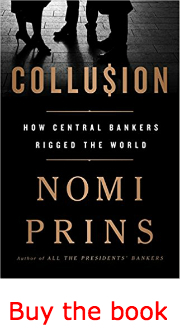 President Trump did try one “all-in” poker move at that summit. With his game-face on, he first suggested the possibility of wiping out all tariffs and trade restrictions between the U.S. and the rest of the G7, a bluff met with a healthy dose of skepticism. Before he left for his meeting with North Korean leader Kim Jong Un in Singapore, he even suggested that the G7 leaders “consider removing every single tariff or trade barrier on American goods.” In return, he claimed he would do the same “for products from their countries.” As it turned out, however, that wasn’t actually a venture into economic diplomacy, just the carrot before the stick, and even it was tied to lingering threats of severe penalties.
President Trump did try one “all-in” poker move at that summit. With his game-face on, he first suggested the possibility of wiping out all tariffs and trade restrictions between the U.S. and the rest of the G7, a bluff met with a healthy dose of skepticism. Before he left for his meeting with North Korean leader Kim Jong Un in Singapore, he even suggested that the G7 leaders “consider removing every single tariff or trade barrier on American goods.” In return, he claimed he would do the same “for products from their countries.” As it turned out, however, that wasn’t actually a venture into economic diplomacy, just the carrot before the stick, and even it was tied to lingering threats of severe penalties.
The current incipient trade war was actually launched by the Trump administration in March in the name of American “national security.” What should have been highlighted, however, was the possible “national insecurity” in which it placed the country’s (and the world’s) future. After all, a similar isolationist stance in the 1920s and the subsequent market crash of 1929 sparked the global Great Depression, opening the way for the utter devastation of World War II.
European Union countries were incredulous when Trump insisted, as he had many times before, that the “U.S. is a victim of unfair trade practices,” citing the country’s trade deficits, especially with Germany and China. At the G7 summit, European leaders did their best to explain to him that his country isn’t actually being treated unfairly. As French President Emmanuel Macron explained, “France runs trade deficits with Germany and the United Kingdom on manufactured goods, even though all three countries are part of the EU single market and have zero tariffs between them.”
Having agreed to sign on to a post-summit joint statement, the president suddenly opted out while on his flight to Singapore, leaving his allies in the lurch (and subsequently slamming the Canadian prime minister as “very dishonest” and “weak”). In that communiqué, signed by the other six summit attendees, they noted, “We strive to reduce tariff barriers, non-tariff barriers, and subsidies… We acknowledge that free, fair and mutually beneficial trade and investment, while creating reciprocal benefits, are key engines for growth and job creation.”
The Pushback
The fallout domestically from the coming trade wars could be horrific if Trump truly makes good on his promises and refuses to back down, while the countries he’s attacking ratchet up their own responses, whether in terms of tariffs or simply a refusal to buy American goods. According to the U.S. Chamber of Commerce, up to 2.6 million American jobs could be threatened if, in the process, the U.S. also withdraws from NAFTA.
Even American CEOs are now running scared of the CEO-in-chief. A recent survey conducted by the Business Roundtable lobby group, chaired by JPMorgan Chase CEO Jamie Dimon, revealed that their “economic outlook index” had declined this past quarter from a record high, the first drop in two years. According to the report, nearly two-thirds of the CEOs surveyed considered trade policy a “serious risk.” Rather than planning future corporate hiring sprees, as Trump might have us believe, their fears of future trade wars actually seem to be curtailing job-expansion plans.
European leaders at the G7 summit admitted that, despite their own role in escalating global trade tensions, the coming wars “would hurt everyone.” And therein lies the danger and the disconnect. Thanks largely to Donald Trump, the leaders of the key countries on the planet could now proceed to destroy trade relationships, knowing full well that the results will hurt their workers and damage the global economy.
A recent report by Andy Stoeckel and Warwick McKibbin for the Brookings Institution analyzed just such a future trade war scenario and found that, if global tariffs were to rise just 10%, the gross national product (GDP) of most countries would fall by between 1% and 4.5% — the U.S. GDP by 1.3%, China’s by 4.3%. A 40% rise in tariffs would ensure a deep global recession or depression. In the 1930s, it was the punitive U.S. Smoot-Hawley tariff that helped spark the devastating cocktail of nationalism and economic collapse that culminated in World War II. This time, who knows what The Donald’s tariffs will spark?
The End Game
When trade wars escalate and geopolitical tensions rise, economies can be badly damaged, leading to a vicious cycle of aggressive responses. And here’s the remarkable thing about the power of America’s imperial presidency in 2018: Donald Trump could unilaterally slow, alter, or under certain circumstances even shut down various elements of global trade — and if he manages to do so, there will be a price to pay in jobs and in this planet’s economic stability.
Catalyzed by tweets, denunciations, insults, and the tariff-first shots of his administration, our allies will undoubtedly try to trade more with each other to close gaps that his trade wars open. Ultimately, that will hurt the U.S. and its workers, especially Trump’s base. For instance, German carmaker BMW, Japanese carmaker Toyota, and other foreign car companies employ 130,000 people in the United States. If, in response to new tariffs on their products, they were to begin moving their operations to France or Mexico in retaliation, it’s American workers who would lose out.
But make no mistake: American allies, who rely on the staggeringly powerful U.S. market, will lose out, too. Weighed down by tariffs, their products will become less competitive here, which is what Trump wants. However, that won’t necessarily mean the end of trade deficits; it could just mean less trade everywhere, a situation that should bring to mind the global depression of the 1930s. And if you think Donald Trump is already a threat to world stability, imagine what might happen after years of economic duress. As was the case in the 1930s, when volatile conditions made it easier for dictators like Adolf Hitler to convince people that their economic woes stemmed from others, the path to a fire-and-fury world remains grimly open.
In Washington, Donald Trump’s unique version of the imperial presidency seems to be expanding to fill any void as alliances like the G7 that were once so crucial to the way the United States dominated much of the planet and its economy are being diminished. The question that should make anybody nervous is not yet answerable: What’s the end game?
The global economic system first put in place after World War II was no longer working particularly well even before President Trump’s trade wars began. The problem now is that its flaws are being exacerbated. Once it becomes too expensive for certain companies to continue operating as their profits go to tariffs or tariffs deflect their customers elsewhere (or nowhere), one thing is certain: it will get worse.

America’s March to Inequality: Why the U.N. Poverty Report Alarms Trump’s Plutocrats
It is no surprise that flacks for the plutocrats in charge of the US like Nikki Haley are squawking about the report on American poverty just issued by UN Special Rapporteur Philip Alston. It throws loads of light on how unequal a society America is, how it is marching rapidly toward even greater, Third World levels of inequality, and how peculiar the US is, as a land of rapacious robber barons and 40 million completely marginalized poor.
The hardest thing for journalism to get right is big structural changes. I was a working journalist in my youth, and when I was blogging events like the Iraq War and the Arab Spring, I was often using journalistic techniques. Your time scale is the past few hours, your focus on the big political players. Personality matters. Details matter. You are zeroed in on trees. Only on a sabbatical (rare enough) do most journalists get a chance to step back and consider the forest. Academics, in contrast, are so consumed by really big forests that they often forget that there are any trees. Hitting the balance is the essence of good social reportage.
Big social statistics are hard to envision. That in a country like the US, with some 320 million people and an $18 trillion annual gross domestic product, the social statistics could be rapidly changing is also hard to fathom.
They are changing, the UN says, decidedly for the worse for tens of millions of people.
*The GOP tax massacre of earlier this year will transfer over time trillions of new dollars to the already obscenely wealthy, and result in diminished government services and a much smaller safety net for the rest of us. It was a tax cut, almost all of the benefits of which went to one-tenth of one percent of the population. It will make them even richer, adding billions to their billions, and make the rest of us poorer. This is a structural change in US society with massive implications.
Already, the top 0.1% holds as much of the country’s wealth as the bottom 90% (i.e. almost everyone reading these words).
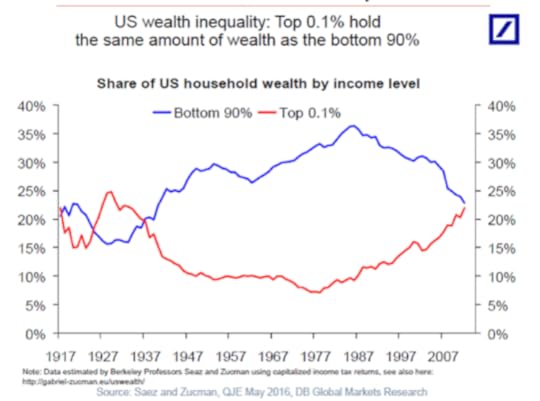
H/t Business Insider
Alston writes,
*US infant mortality rates in 2013 were the highest in the developed world.
*Americans can expect to live shorter and sicker lives, compared to people living in any other rich democracy, and the “health gap” between the U.S. and its peer countries continues to grow.
*U.S. inequality levels are far higher than those in most European countries.
*Neglected tropical diseases, including Zika, are increasingly common in the USA. It has been estimated that 12 million Americans live with a neglected parasitic infection. A 2017 report documents the prevalence of hookworm in Lowndes County, Alabama.
*The US has the highest prevalence of obesity in the developed world.
*In terms of access to water and sanitation the US ranks 36th in the world.
*America has the highest incarceration rate in the world, ahead of Turkmenistan, El Salvador, Cuba, Thailand and the Russian Federation. Its rate is nearly 5 times the OECD average.
*The youth poverty rate in the United States is the highest across the OECD with one quarter of youth living in poverty compared to less than 14% across the OECD.
The UN report violates the basic tenet of the propaganda of our robber barons, which is that things are getting better. They are getting worse, and dramatically so.
One reason Nikki Haley, current US ambassador to a UN she doesn’t believe in, and the former governor of South Carolina, is in such high dudgeon about the UN report is that she exemplifies everything wrong with America. She ran a state with one of the lowest life expectancies in the US and one of the highest infant mortality rates.
And the reason South Carolina elites cannot believe these statistics and are so embarrassed by them is that they are deeply about race and class. African-American health statistics in South Carolina are in third-world territory because the state is run as a caste system. Haley, as an Indian-American, managed to make the leap into whiteness by rendering her Sikhism ambiguous and often talking like an Evangelical, and by marrying into the dominant caste.
The Trump tax massacre was intended to take even more from African-Americans and Latinos and other minorities and transfer it to the largely English, Scottish, German and other Northern European business elite (the wealth of some of whom began accumulating in the nineteenth century through slavery or criminal activities).
I wrote about all this just a few years ago:
Average household net worth of whites: $110,000
Average household net worth of African-Americans: $5000
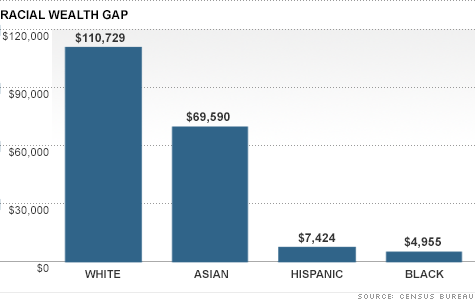
The wealth gap between white and African-American families tripled between 1980 and 2009, according to the Century Foundation:
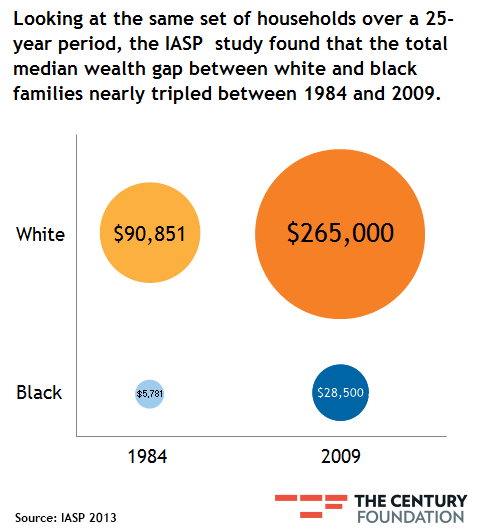
One in every 15 African American men is incarcerated in comparison to 1 in every 106 white men.
So if the UN report were taken seriously, the US would require a social revolution to even approach the normality of a France or Germany, where a handful of billionaires don’t take food out of the mouth of hungry babies.
And that is why the shock troops of Trumpism are so eager to discredit it.

Sarah Huckabee Sanders Ejected From Virginia Restaurant
WASHINGTON—White House press secretary Sarah Huckabee Sanders was booted from a Virginia restaurant because she works for President Donald Trump, setting off a fierce debate about whether politics should play a role in how administration officials are treated in public.
Sanders was the latest to experience a brusque reception in such a setting.
Sanders tweeted that she was told by the owner of the Red Hen in Lexington, Virginia, that she had to “leave because I work for @POTUS and I politely left.” She said the episode Friday evening said far more about the owner of the restaurant than it did about her.
“I always do my best to treat people, including those I disagree with, respectfully and will continue to do so,” Sanders said in the tweet from her official account, which generated 22,000 replies in about an hour.
The restaurant’s co-owner Stephanie Wilkinson told The Washington Post that her staff had called her to report that Sanders was in the restaurant. She cited several reasons, including the concerns of several restaurant employees who were gay and knew Sanders had defended Trump’s desire to bar transgender people from the military.
“Tell me what you want me to do. I can ask her to leave,” Wilkinson told her staff, she said. “They said yes.”
Wilkinson said that she talked to Sanders privately and that Sanders’s response was immediate: “That’s fine. I’ll go.”
Employees at the restaurant told The Associated Press that Wilkinson wasn’t available for further comment.
Over the weekend, former House Speaker Newt Gingrich weighed in on the increasingly nasty tone of politics. Gingrich was known for setting a more combative tone in congressional politics in the 1990s.
“The increasing personal nastiness toward people who work for President Trump reflects the left’s understanding that they are losing,” Gingrich said in a tweet. “Nastiness reflects desperation, not strength. They can’t win the argument so they use nastiness. Sad and dangerous.”
Lexington, located in the Shenandoah Valley and a three-hour drive southwest of the nation’s capital, is politically a spot of blue in a sea of red. It sided with Democratic nominee Hillary Clinton in the 2016 presidential election, by a 2-1 margin. It’s the county seat of Rockbridge County, which went with Trump by a similar margin. And it is home to Virginia Military Institute and Washington and Lee University.
Sanders’ treatment at the restaurant created a social media commotion with people on both sides weighing in, including her father, Mike Huckabee, a former Arkansas governor and Republican presidential candidate.
“Bigotry. On the menu at Red Hen Restaurant in Lexington VA. Or you can ask for the ‘Hate Plate,’” Huckabee said in a tweet, quickly generating 2,000 replies in about 30 minutes. “And appetizers are ‘small plates for small minds.’”
Tom Lomax, a local business owner, brought flowers to the restaurant Saturday afternoon as a show of support. He called Wilkinson a “force of nature” and “one of the biggest drivers of the downtown.”
“We support our own here, great little community we have,” he said.
Stephen Russek, a former restaurant owner in the area, said “they had no right to do that.”
“You have your political opinions, you don’t throw somebody out of your restaurant,” Russek, who lives nearby, said. “They ought to be shut down.”
The separation of families trying to enter the U.S. at the southern border has intensified political differences and passions that were already at elevated levels during the Trump presidency.
Earlier in the week, Trump’s Homeland Security secretary, Kirstjen Nielsen, cut short a working dinner at a Mexican restaurant in Washington after protesters shouted, “Shame!” until she left. A few days earlier, Trump aide Stephen Miller, a key adviser on immigration, was accosted by someone at a different Mexican restaurant in the city, who called him “a fascist,” according to the New York Post. The Trumps don’t get out a lot socially in Washington and Trump often dines at BLT Prime in the Trump International Hotel or at Trump properties elsewhere when he does go out.
Ari Fleischer, who was a press secretary for President George W. Bush, tweeted Saturday: “I guess we’re heading into an America with Democrat-only restaurants, which will lead to Republican-only restaurants. Do the fools who threw Sarah out, and the people who cheer them on, really want us to be that kind of country?”

June 23, 2018
With Driving Ban Lifted, Saudi Women Are in Crosshairs of Change
RIYADH, Saudi Arabia — Outside a sprawling mall in the Saudi capital, Riyadh, young single men and women walk through an open-air exhibit where Saudi women and traffic police explain the ins and outs of handling a car. Children take a lap around a makeshift course in tiny electric cars as clowns appear on a small stage, dancing for the crowd. A song with a woman’s voice blares through the loudspeakers, singing: “I love you Saudia. My love, Saudia.”
Just four years ago, this government-sponsored event was an unthinkable scene in the deeply religious and socially conservative country.
But the most visible sign of change came on Sunday, when women in Saudi Arabia were allowed to drive, ending a ban that had stained the kingdom’s reputation globally, kept women subjugated in the backseat and hindered the full potential of the country’s economic growth.
The move places Saudi women at the heart of a major transformation being spearheaded by the country’s Crown Prince Mohammed bin Salman. It also places women at the center of a tug-of-war between those agitating for more openings and a religious majority that remains wary of changes that could be influenced by the West.
It was only a few years ago that religious police— known for their long beards and shorter white robes— enforced an austere interpretation of Islam that banned music of any kind in public, much less the sound of a woman’s voice on loudspeakers. They could detain groups of unmarried men and women for simply standing around or sitting together. They ensured restaurants and stores closed their doors for daily prayers and waved sticks at women who had their hair or face uncovered, shouting through microphones attached to the tops of their cars as they patrolled the streets.
Unlike previous Saudi monarchs who took cautious, incremental steps to reform the country, King Salman has granted his 32-year-old son and heir, the crown prince, a free hand to usher in dramatic moves that are reshaping the country. Allowing musical concerts, opening movie theaters, easing restrictions on gender segregation and reigning in the powers of the religious police have all been signature reforms of the young prince.
He’s seen as the force behind the king’s decision to lift the longstanding ban on women driving this Sunday.
“I can say that Mohammed bin Salman, the crown prince, came at the right time. He is young and motivated,” said Lulwa al-Fireiji, speaking at Friday night’s event to encourage women to drive.
Al-Fireiji, 60, quickly clarified that while there was “nothing wrong” with previous Saudi rulers, now is the time for change.
“I will get a license, but I won’t drive right away because the elders are always scared. But the young people are motivated and we need at this time someone like Mohammed bin Salman – motivated, God bless him, and daring. He will move the country (forward) faster,” she said.
Granting women the right to drive is part of a wider blueprint for the future drawn up by the crown prince. In an era of sustained lower oil prices, the government is pushing Saudis to become less reliant on the government for jobs, handouts and subsidies. Some 70 percent of Saudis who work are employed in the public sector and rely on the government for their wages.
Official statistics show that women make up the overwhelming majority of job seekers in Saudi Arabia and that around 34 percent of Saudis seeking employment are between 25 and 29 years old.
The state alone cannot create enough public sector jobs to keep up with the pace of Saudis seeking work, so foreigners are being booted out of jobs at restaurants, banks, cell phone repair shops and many sales floors to make way for Saudis. Companies are required to stack their workforce with a minimum number of Saudi nationals or face heavy fines.
To encourage two-income households, Saudi women are taking on jobs that were once reserved for men at lingerie shops and makeup stores. And Sunday, when they start driving, many will be able to get more easily to work and will no longer need to hire drivers, who often hail from India and Pakistan. Women will even be allowed to work as drivers.
Prince Mohammed is set to inherit a country where more than half of its 20 million citizens are under the age of 25. Many are active on social media, where Saudis are vocal about the pace of change.
Just last week, conservative citizens took to YouTube and Twitter to criticize a Russian circus that included female performers in body-hugging leotards. Before the show could finish its four-day run in Riyadh, the king had fired the head of the entertainment authority.
Under the crown prince, the message pushed by officials is that Saudi Arabia is modernizing, not Westernizing. The prince has branded the reforms as a return to “moderate Islam”. Even the country’s ultraconservative clerics, who for decades warned against allowing women to work and drive, have toed the line with muted statements of support.
The tightrope the government has to walk between “a shrinking insular and traditionalist majority and a growing progressive and internationalist minority” is a defining feature of modern Saudi Arabia, said a report by the Arabia Foundation, a Washington-based think tank that has links with the Saudi government.
The report said the government maintains a delicate balance between reformers and conservatives by “monopolizing the reform process”, pre-empting and suppressing grassroots activism or, on occasion, tolerating it as a safety valve for expressing grievances.
Just last month, the pendulum appeared to swing away from the latter when several prominent women’s rights activists who were at the forefront of calls to lift the driving ban were arrested. At least 10 are still being held in an undisclosed location with no access to lawyers.
The arrests highlight how quickly the levers of reform can be pulled back.
“It looks like the only reform they want is the one that comes from above and any sort of calls for changes, no matter how positive they are and will benefit the country, will not be tolerated from below,” said Kareem Chehayeb, a researcher at Amnesty International.
Three of the women still detained— Aziza al-Yousef, Loujain al-Hathloul and Eman al-Nafjan— are seen as icons of a larger democratic and civil rights push in the kingdom. The women had also been calling for an end to guardianship laws that give male relatives final say over whether a woman can marry, obtain a passport or travel abroad.
Since their arrest, the women have been branded traitors by state-aligned media. Prosecutors accuse them of working with foreign entities and attempting to harm the interests of the kingdom.
It comes after Prince Mohammed oversaw the arrests of dozens of writers, moderate clerics and others last year for apparently not emphatically supporting his policies, including the Saudi-led war in Yemen and a standoff with Qatar. In November, he further consolidated power when he arbitrarily detained influential businessmen, officials and at least a dozen high-level princes in a purported anti-corruption campaign.
The arrest of the women’s rights activists just before women are allowed to drive sends a message that “you are subjects and not citizens” and that the Saudi leadership alone controls when and how change takes shape, said Kristin Diwan, a senior resident scholar at the Arab Gulf States Institute in Washington.
“You could get the idea that OK now we’re allowing driving and allowing a real opening, but that kind of encourages women to demand and ask for more,” she said. “I think they want to make sure that that is not the message they’re communicating. You cannot make demands on the government. The government will decide what policies are best.”
Truthdig is running a reader-funded project to document the Poor People’s Campaign. Please help us by making a donation.

‘Do You Know Your Right of Publicity?’ (Audio and Transcript)
In this week’s episode of “Scheer Intelligence,” host and Truthdig Editor in Chief Robert Scheer traces the shifting boundaries of publicity with someone who knows a thing or two about the topic. In fact, it’s fair to say his guest, Jennifer Rothman, wrote the book on it.
Rothman, a law professor at Loyola Law School, has been at the forefront of defining publicity, identity and privacy rules in the internet age. She’s done the work of sorting out the interrelated and tricky considerations involved in balancing self-promotion with self-protection at a time when image management has become an issue that isn’t reserved only for celebrities and elected officials.
Listen and learn from the expert herself in conversation with Scheer in the player below, and read the transcript that follows. Find past episodes of “Scheer Intelligence” here.
Robert Scheer: Hi, this is Robert Scheer, and you’re listening to Scheer Intelligence, kind of the poor man’s Central Intelligence Agency. My guest today is Loyola Law School professor and author Jennifer Rothman. Her latest book is called “The Right of Publicity: Privacy Reimagined for a Public World,” published by Harvard University Press. Jennifer Rothman, welcome.
Jennifer Rothman: Thank you.
RS: And the reason I wanted to do this interview is we had kind of a confusing panel about privacy and publicity at the Los Angeles Times Book Festival. And I thought after–you know, sometimes you just get off one of these panels–and I thought we were like ships passing in the night. I was stressing the surveillance state and privacy and the Fourth Amendment; and then we had a person, I’m blocking on his name, but he was very much into the technology, stressing that. And then you were coming from an area that I hadn’t thought much about, or if at all, and yet it’s incredibly important, because it concerns how much we know about people that otherwise are public people; they’re movie stars, they’re politicians, and their ability to control their image, I think, is the real issue, particularly in the time of the internet. Famously, the case of Martin Luther King, where his heirs can control even access to his speeches. And you’re kind of the maven of this in law, right? You’ve invented, or owned, or are the leading scholar in this area.
JR: Yeah, I don’t think I own this space, but I am known for being the leading scholar, and this is one of the first major treatments, book treatments of the subject. And the right of publicity is a law that most people don’t know about, but that affects all of us. And everyone actually has this right under state law; it’s the right to control your own identity, usually your likeness or voice or name. And you can stop others from using it, or collect money damages if they do without your permission. And this presents a host of opportunities in today’s digital age, where privacy has really fallen down on the job in many respects, because it narrowed over time to really just be, in the context of state laws, to really apply to secrets, or when people are secluded in their homes. But the right of publicity covers information that’s out in the public–your name, your likeness and voice–and so it’s not about secrecy or seclusion, it’s about control. So this has some opportunities for your average person to combat things like Facebook using you in advertisements, or selling information about you; it applies, you may be able to use it to stop revenge porn or deal with mugshot sites that are using arrest photos. But it also has a number of risks, and one of them you just highlighted, which is the ability of public figures to shut down speech about them, and shut down uses of their name and image and voice, which can shut down creative works like movies as well as internet discussions about public figures, and even the use of clips of Martin Luther King giving speeches.
RS: Yeah. So let me, first of all, you say it’s a matter of state law. So it varies from state to state?
JR: Yes.
RS: And so, what, California has the harshest because we have more movie stars, or how does it work?
JR: Well, that’s actually very insightful. California does have a very robust right of publicity. We have three separate rights of publicity in California; most states only have one. And we have rights for dead people, to protect their names and likeness and voice, even when they’re gone; and which can create a major windfall for some. And we also have rights for the living, both statute and common law, very broad; rights for the dead last 70 years after their death. Other states just incorporate this into state privacy laws and are more modest. Some states, like Utah, limit it to instances in which there’s confusion as to whether a particular person sponsored the use or endorsed the use. So there’s great variability. And I actually started a website where you can click on your state and find out the laws of the state, because they vary so dramatically. It’s Rothman’s Roadmap to the Right of Publicity, RightofPublicityRoadMap.com, and I also have breaking news there.
RS: I just want to connect this a little bit with the European Union Google issue, which has bothered a lot of people; the European Union said you have the right to control your image on the internet to some degree, and if you feel something is inaccurate–does that apply here?
JR: So they overlap. I think you’re referring to the right to be forgotten.
RS: Yes.
JR: And there’s some reasons why we might be sympathetic to that; particularly young people making bad decisions, and then all of a sudden photos of them getting into trouble are all over the internet, and it’s very difficult for people to start over or get jobs. And so the EU, as a matter of personal right, is protecting this right to be forgotten. We do not have that in the United States, and it’s very much intention with our commitments to free speech and the First Amendment. So the right of publicity in some respects is our version, but it’s not about being forgotten, or hiding history; it’s about controlling information about yourself.
RS: But it has a similar impact. And I just want to–let’s say, OK, myself; OK, let’s say I gave some dumb speech, and I don’t really want people to read it, or I wrote something or said something. I could then copyright it, right, in effect. Or my heirs and I could say in perpetuity, I don’t want this thing referenced.
JR: There’s a difference between copyright and the right of publicity. So copyright is about works of expression that are in a fixed form. So if you write a book, if you give a speech that you’ve written out, or if it’s recorded, that would also benefit from copyright. But copyright has very broad fair use provisions that allow–especially if someone’s not trying to take all the market value or sell it, is just trying to refer to it and document excerpts of it to say what you said, or to comment on your speech–copyright is going to have broad protection for that.
RS: So let me just take Martin Luther King’s, because this has been one area people are trying to, some people mistakenly, I think, trying to protect his image, where in fact they’ve actually excluded our use of his product. And I’m thinking of one particular speech, he gave a very strong speech at Riverside Church condemning the Vietnam War. And I’ve tried to run that speech on our site and elsewhere, and you really run afoul of, I guess it’s his trust, or his heirs. And they can say, we don’t want, we have to give you permission to have his speech. Is it only his voice? Can they control the text?
JR: Yeah, so the estate is very, the Martin Luther King, Jr. estate is very litigious. And they have tried to stop people from sharing his speeches, both the written text of his speeches and video clips of his speeches, and have been fairly successful. Movies and television shows have been paying the estate for permission to use his words, to show clips. And part of that is about copyright; the copyrights to the speeches and some of the video images, if they have control. The other part is the right of publicity, and they’re claiming they have a right to decide when his name and likeness and voice are used. And the U.S. government actually paid $800,000 for the statue honoring Martin Luther King in D.C., which is sort of shocking, because it seems like it’s in the public domain to honor him. The estate has also shut down the sale of Martin Luther King busts, or the sculptures that people could buy to honor him in their house, and to celebrate civil rights, and the estate said no, you don’t have the right to do that, and have been successful at stopping those uses. I don’t know if you watched the Super Bowl, but before the Super Bowl there was a Dodge commercial for a truck that used an excerpt of a Martin Luther King speech, and they did get permission from the estate, but people were outraged, because it seemed offensive to the memory of Martin Luther King, Jr. And his own daughter disclaimed, and the Coretta Scott King Foundation disclaimed their involvement in authorizing that.
RS: OK, but take us through this, because I think most people listening to this would not understand that the U.S. government could not commission an artist to do a sculpture of Martin Luther King, right, that’s going to be out in the public; they have to have the permission of his estate?
JR: Well, that is a gray area. And the U.S. government decided they didn’t want to fight with the estate or risk a lawsuit, and so they paid a large sum of money.
RS: On what basis? I mean, why can’t any artist in the world conjure up an image of Martin Luther King and make a sculpture or a painting or something? Why can’t they do that?
JR: Yes, I think it’s absurd, and somewhat gutless, by the government to be afraid and feel like they had to pay. But these are the sorts of uses, in single works of art or statues, that generally have been allowed. But on its own terms, the right of publicity, and the one that is involved with Martin Luther King, he–they’re now right after he’s dead, that his heirs have, and they can prevent uses of his name, likeness, and voice, unless either the state law has an exception, or you litigate and the First Amendment is held to protect the use. And I think in this instance, the freedom of speech would have protected the use; single statue honoring him and a short quote from one of his speeches would have also been allowed under copyright law.
RS: OK. So let’s make a, have an unflattering reference. Let’s say we have a, not a wonderful human being like Martin Luther King, we had, say, an American demagogue who was, you know, anti-Semitic and racist and homophobic and misogynist, OK, and was a senator, say, from South Carolina or something. And print their speech because it reflects all that. Isn’t there a free press, free speech right to do that without having the permission of the heirs?
JR: Yes. So I want to highlight again the difference between copyright and the right of publicity. So copyright would protect the speech, and then if you’re using an excerpt of the speech, that’s going to be a fair use, it’s going to be allowed. The right of publicity is just focused on the name and the likeness and voice. So again, if you’re referring accurately to someone, those are the sorts of uses in journalism and commentary that courts have allowed. Where it starts to get more problematic tends to be in cases where there is deemed to be some sort of commercial profiting. And sometimes the commercial profiting is in video games or in movies, which are making a profit. Or sometimes it’s in merchandise. So the Martin Luther King busts were sold for money, although part of it was donated. You can think of, there’s an artist Rick Rush who painted pictures of athletes, and notably painted a picture of Tiger Woods winning the Masters, and then he sold copies of his lithographs referring to Tiger Woods. Tiger Woods sued for a right of publicity violation, as well as some trademark violations. There the court said that the use was protected by the First Amendment in this artistic work. But we have cases that have come out another way, very similar cases in other states. For example, in California the estate of the Three Stooges sued over an artist’s rendition of a portrait of the Three Stooges, a realistic charcoal lithograph which was sold both in print, but also sold on T-shirts. And the California Supreme Court said the First Amendment didn’t protect this artistic use because they were profiting, the artist was profiting financially from the sale of the Three Stooges.
RS: So what if the T-shirt had attacked the Three Stooges and said, you know, they’re reprehensible and their comedy sucked, and then we got a picture of them, you show them being foolish, and then you had some text–that would probably be First Amendment protected, right?
JR: I think that instance, where there’s critical commentary, likely would have come out the other way and been allowed. And that’s something I talk about in the book, because the California Supreme Court contrasted this artist Gary Saderup’s painting of the Three Stooges with works by Andy Warhol. And of course Andy Warhol famously painted celebrities and made a lot of money selling his pictures, but he added some color, or changed the saturation of even black and white images. And so the question is, where, how do we determine what’s allowed and what’s not? So maybe a negative comment, but would a picture of the Three Stooges where you add color or you add a few other comedians, or you seem to be making a commentary, come out the other way? And so there’s a lot of uncertainty about what’s allowed and what’s not, and people are afraid of being liable for these right of publicity claims, and that affects what works get created.
RS: The book is called “The Right of Publicity.” Now, first of all, this right, does it go back to the Magna Carta? Does it go back to the Old Testament? You know, where does this right come from? It’s just a bunch of states at different points passed laws because they were under pressure from people who wanted to preserve their image or their product, right?
JR: Yeah, so this is, this right of publicity is not a constitutional right. However, it emerges from state law in the 1800s, and like many of our laws are, started in what’s called the common law. And that is just laws that courts make, and here is based and rooted in the notion of personal autonomy and having some zone of control over your own identity. And it started in the 1800s, largely with the emergence of what were called detective cameras, the first Kodak cameras, and people were walking down the street and all of a sudden someone could take their picture. And then they’d find it on the front page of the newspaper, or they’d find it in an advertisement for flour or life insurance, and there was an outcry by–including by journalists, surprisingly–but by average citizens, journalists, and prominent figures at the time, all calling for this right to stop unwarranted publicity about oneself, and to be able to control the use of one’s name and image. And these were the very first privacy rights that were adopted in the United States, long before the broader constitutional right of privacy emerged.
RS: [omission for station break] My guest is law professor Jennifer Rothman, who is really a pioneer in a very important and controversial area of law. And the title of her book, “The Right of Publicity: Privacy Reimagined for a Public World,” published by Harvard University Press, and she’s a professor at Loyola Law School. Why are you passionate about this? Why is this important?
JR: There are three things that drove me to write about this. And one is that I think this is an era in which so much of our information is out in public, and can really destroy people’s lives; and privacy law is not helping, particularly average citizens. Meanwhile, this right of publicity is giving a profound boost and control to very prominent public figures in ways that are shutting down free speech. And that seems to me to be exactly backwards; that the people who most need to have more leverage to control how their identity is being used have the least control, in the way we’re currently understanding the laws, while those who we need to speak about the most are able to shut down speech about themselves.
RS: Why can a well-known person control their image and an ordinary person doesn’t? Is it a matter of resources, or being able to go into court, or setting up a trust, or–?
JR: Well, it has happened because of how the law has been misunderstood. And that’s part of the mission of the book, is to talk about how this right of publicity is really one and the same as the original right of privacy, which is more focused on protecting individual rights than just economic rights.
RS: This is the thing I did not understand on our panel, and I did not get clearly from working my way through your book, which is a very good book, but it deals a lot with complex legal issues, though there are a lot of really good examples there. But take me through that. That’s the part I missed. That you really are an advocate for privacy for ordinary people, and you think this law should properly be used to extend that.
JR: Yes. And so what happened was that the right of privacy and the right of publicity turned into this intellectual property right, like copyrights or patents. And what that has done is given a very robust ownership right by people who are deemed to have commercially valuable rights of publicity–so those are usually the public figures, the celebrities. And so they’re deemed to be more valuable than others. And there was a court case involving “The Hurt Locker,” the Academy Award-winning movie, and the army sergeant who thought the movie was based on him sued, saying they’d used his identity. And he lost his lawsuit, which I think was the correct outcome in that instance. But the court said it would be different if he had a commercially valuable personality; if he earned money sort of selling his identity, the way actors and celebrities do. And so unsurprisingly, we then had Olivia de Havilland, a two-time Academy Award-winning actress, you know, understand that to be a signal that she could sue if someone used her identity in a similar biographical picture. And that’s exactly what she did, arising out of the miniseries Feud. And so that seems to me exactly backwards; that we would shut down speech about these people who aren’t replaceable; we need to refer to Olivia de Havilland if we’re telling a story about Olivia de Havilland. The other problem with the shift to the intellectual property framework–and this is another thing that people don’t realize, and that I think is quite dangerous, and drove me to write the book–is that by making it an intellectual property right, it can be taken away from people. Which, it may be problematic if someone takes your car; if you declare bankruptcy and you lose your car. But it’s even more chilling if you declare bankruptcy and you lose the right to your own name and voice and likeness. And that’s what can happen when we understand the right of publicity as we often do today, as this transferable, intellectual property right.
RS: Let me ask you, there’s one case that comes up, I think that involved a UCLA basketball player who showed up in a video game, his likeness. And there’s a lot of college athletes have been used in that way, and they don’t get money from this thing, so they sued. And I think successfully stopped it, is that correct?
JR: Yes. So there were a series of lawsuits by athletes, student athletes and professional athletes, about the uses of their identities. And there were a number involving video games. And so the video games recreated historical rosters’ players, and they licensed the NCAA, and the NCAA made a lot of money about this. But it also raises some of the free speech issues, because you’re describing actual players who played on actual teams, and statistics, very much like fantasy sports. And that the Supreme Court recently gave sort of a broader license to be able to do by legalizing sports gambling. And so the question is, how much control do athletes have over these uses of their identity? And the, in the video game cases, several federal appellate courts said the First Amendment doesn’t protect those uses, and that the athletes have to be paid. Now, as a matter of First Amendment law, I think that’s wrong, and very troubling. Because it’s shutting down speech about real people, and accurate descriptions of history; you can imagine that it would really limit biographical video games. On the other hand, student athletes, I think, are greatly mistreated by the NCAA. And actually until recently the NCAA had the students sign contracts, as a condition for playing and for getting their scholarship money, that transferred their rights of publicity–their rights to their names, likeness, and voice–in perpetuity, forever, to the NCAA. And so that’s very much in the heartland of what’s concerning to me, that these student athletes who have no leverage would be forced to sign their rights of publicity to the NCAA. And then of course if the NCAA owned the rights, they could not only license the student athletes in video games, but they could have them appear in advertisements or all sorts of products without further permission from the athletes, for the rest of the athletes’ lives, and even after death, under many of these laws.
RS: So what’s the current status of that? Can you grab an athlete’s image and exploit it? The NCAA is particularly offensive in that way.
JR: It depends on the context. So in video games, it seems not; that you need to get permission, at least depending on the type of video game, from the athletes. But there are other cases involving the use of photographs that the NCAA took of the students while they were playing, and courts have allowed those photographs to be sold by the NCAA without additional permission or payment to the student athletes.
RS: “The Right of Publicity: Privacy Reimagined for a Public World.” And it could just as easily say, “Privacy reimagined in the age of the internet.” Wouldn’t that be also? I mean, the public world is really this internet that we are living in now. And do you think it’s hopeless–or, obviously, you don’t; you wrote this whole book–can we really have sensible rules of the road for the internet in this regard?
JR: Yes, I think that the right of publicity is one of the opportunities for preserving the concept, the broader idea of privacy, and what we really want in the internet age. So it used to be that you would write a letter and no one would see it, and now, you might write a blog post or share images on Instagram, and if you ask–sometimes people say, particularly older people looking at the younger generation, will say “Young people don’t care at all today about privacy.” And when you dig down a little deeper and ask the younger people about what their preferences are, they actually care a great deal about privacy. What they don’t care as much about is secrecy. But they care very much about control. So they might want to share where they’re eating or what they’re eating or who they were with or their blog post, but they want to be able to control what else is done with it. So by putting it out on the internet, they’re not saying, here, take this and do what you want with it. They’re sharing it, but also want to control its future use. So they would be as upset as anyone else if it then got used, say, in an advertisement, or if Facebook coopted it and started disseminating it. Twitter has started selling playing cards with Twitter users on it, and didn’t get additional permission. Those are the sorts of uses, even if someone puts an image out there on the internet, that they want to be able to control. It’s often said that privacy is dead, but that’s only by people who really don’t understand what the original concept of privacy was.
RS: Right, but you’ve put your finger on the main contradiction, which I find–I don’t know about your students, but I find my students at USC, that this is it. They’ll at first say, who cares, so Yelp knows where I ate, and so Facebook has this. And then, if any of them in the room have experienced the misuse of that information–they’ve been stalked, they’ve been defamed, their pictures have been distorted, their private information–suddenly, they’re very much for controlling it. And it really even goes to political expression–well, very much so. If you don’t think you’re going to do anything that disturbs the government, or disturbs powerful people, then you say who cares if you know what I read or what movies I watch or my letters. But if you think you might say something controversial, then there’s a different sense. And I think Mark Zuckerberg’s idea, really, was that we would be a passive nation of consumers. And in the interest of more effectively consuming, we would reveal everything about ourselves–our clothing sizes, our tastes–right? So we would get product placement near us. And I think we now have had a moment, a time of reckoning, that no–this could really hurt you. Do you get a sense of a shift in attitudes in response to your book?
JR: I think that there’s growing awareness. And certainly the Cambridge Analytica coverage made people more aware of how their information is being used in ways that they were not aware of, and that they don’t agree with. And the right of publicity is one way to try to push back on that by giving people a lever of control. It’s not the only way, and I think that there needs to be probably some government regulation in this space as well, particularly related to online privacy. But the right of publicity starts by giving people a baseline of control over their name, likeness, and voice, and some other aspects of identity. And I think it’s something that everyone needs to be very aware of in the digital age. Because not only does it have this opportunity, but it has these risks. So when you repost things, you could potentially be liable for violating someone else’s right of publicity, and you might unwittingly assign your right of publicity to someone else, whether it’s Facebook in terms of service that you haven’t read, if they decide to be more expansive, or if you’re an aspiring actor or model or singer or athlete, in your contract. So it’s something that people really need to be attuned to. And as I said, when people repost things, they may potentially open themselves up to liability. For example, if they’re using celebrities to mash up new videos, they may be liable for a right of publicity violation. Reese Witherspoon has sued over repostings of her Instagram and Twitter, I believe, from jewelers and fashion companies that reposted images of her wearing their products or using their products. So you can imagine individuals doing that as well.
RS: Right now all we have is opt out. If you know something is being misused in some data, you can make a complaint and try to get it withdrawn, and so forth. The onus is on you to discover it, to be aggressive about getting it changed, and so forth. If we had a rule, and this was proposed early on in the age of the internet, of opt in, that before they can use your data for a purpose different than what you intended–in other words, I’m going to pick a restaurant tonight, and that’s all my reason, is I’m giving you information to pick that restaurant, and what I order even, or what have you. I don’t want that shared with someone else who’s marketing this, or exploiting this, and so forth. Why can’t we just have a simple opt-in rule, that before they can use your data for some other purpose, they have to have your permission?
JR: I think that opt in is crucial to preserving privacy in this country and in the internet world. It just hasn’t happened yet as the default. But I think that the opt out will not work. And what we mean by this is that the default should be that your privacy and your information is protected, and if you want to give it up, if you want them to share it, you’re affirmatively giving that permission in every instance in an informed way, rather than just in a blanket, click-through license that no one reads. And I think that’s essential. The right of publicity is just one step in that, by having the default be that people have some control over that identifying information about themselves. Now, some of it is anonymized, and then we need other controls. And the government, of course, can establish a requirement of opt in, that information about people is only revealed when they are specifically asked and informed in every instance, and give permission. But they haven’t done that yet.
RS: The whole question of can you get legislation that protects the individual. And I remember when we had the Financial Services Modernization Act, the thing that allowed commercial and investment banks to get together and merge their activities, and we even had insurance companies forming with banks–all this data was suddenly available, and this was in the late 1990s. Interesting coalition of conservatives like William Safire, who had been Nixon’s speechwriter, was a New York Times columnist; Ed Markey, who’s now a senator from Massachusetts; you could find a whole number of these people, said no, we have to have opt in. If you don’t have opt in, you have no protection. And so it isn’t that this is, oh, maybe we should do it–no, there are active lobbying groups, and the people who want to commercially exploit our private data are the people who always say, no, you can’t do this. And they win, because they have campaign money they can throw at it. So isn’t it really that the solution here that’s available to us is one that we’re not even discussing, let alone implementing? That you should be able to control how the data you offer up, say on Facebook, is used?
JR: Yes, I think that there are multiple things that have to happen. So one is that this right of publicity can be wielded more, and we’re starting to see more lawsuits and pushback in that regard. Second, you’re right, the legislation may be an uphill battle given the various lobbyists. But there may be some market opportunities here for competitors to offer more privacy protected options, and that’s true in other spaces. In the internet, for example, there are search engines that are more protective of privacy than others, and they’re currently free. But it’s also true that people have been sort of lured into giving up their privacy by having these free services, and people need to be willing to pay for privacy. There may be a space where we need to educate people, but we also may need some people who are willing to provide free services that are more privacy protected, maybe nonprofit models.
RS: Check out the book, “The Right of Publicity: Privacy Reimagined for a Public World,” at Harvard University Press. And I’ve been talking to Jennifer Rothman. That’s it for Scheer Intelligence. Thanks to my guest. The producers of Scheer Intelligence are Rebecca Mooney and Joshua Scheer. The engineers at KCRW are Mario Diaz and Kat Yore. I’m Robert Scheer. See you next time.

DOJ Gives Congress New Classified Documents on Russia Probe
WASHINGTON — The Justice Department says it has given House Republicans new classified information related to the Russia investigation after lawmakers had threatened to hold officials in contempt of Congress or even impeach them.
A spokeswoman for House Speaker Paul Ryan said Saturday that the department has partially complied with subpoenas from the House Intelligence and Judiciary committees after officials turned over more than a thousand new documents this week. House Republicans had given the Justice Department and FBI a Friday deadline for all documents, most of which are related to the origins of the FBI’s Russia investigation and the handling of its probe into Democrat Hillary Clinton’s emails. Ryan spokeswoman AshLee Strong said the department asked for more time and they will get it — for now.
“Our efforts have resulted in the committees finally getting access to information that was sought months ago, but some important requests remain to be completed,” Strong said in a statement Saturday. “Additional time has been requested for the outstanding items, and based on our understanding of the process we believe that request is reasonable. We expect the department to meet its full obligations to the two committees.”
The efforts by the Justice Department over the last week to deliver documents to the House Republicans appear to have at least temporarily diffused a monthslong standoff with Congress. Democrats have criticized the multiple document requests, charging that they are intended to discredit the department and distract from or even undermine special counsel Robert Mueller’s investigation into the Trump campaign’s Russia ties and whether there was obstruction of justice.
In a letter sent to House Intelligence Committee Chairman Devin Nunes, R-Calif., late Friday, the Justice Department said it had that day provided a classified letter to his panel regarding whether the FBI used “confidential human sources” before it officially began its Russia investigation in 2016. Bolstered by President Donald Trump, Nunes has been pressing the department on an informant who spoke to members of Trump’s campaign as the FBI began to explore the campaign’s ties to Russia. Trump has called the matter “spygate,” though multiple Republicans who have been briefed on the informant have downplayed its significance.
In the letter, the Justice Department’s acting assistant director of congressional affairs, Jill Tyson, said Nunes had also asked for transcripts of conversations between confidential human sources and Trump campaign officials. She said the department had referred that request to National Intelligence Director Dan Coats.
Tyson’s letter said the department had also given Nunes materials related to the department’s guidelines under the Foreign Intelligence Surveillance Act. Republicans have for months questioned whether the department abused that act when prosecutors and agents in 2016 applied for and received a secret warrant to monitor the communications of Trump campaign associate Carter Page.
The department is also working to provide outstanding documents related to former British spy Christopher Steele, Tyson said, and the dossier he compiled of anti-Trump research during the presidential campaign. Trump and congressional Republicans have charged that the research in the dossier, paid for by Clinton’s campaign and the Democratic National Committee, was used inappropriately to obtain the warrant on Page.
House Speaker Paul Ryan has backed the document requests, and he led a meeting last week with committee chairmen and Deputy Attorney General Rod Rosenstein to try to resolve the issue. In a television interview two days after that meeting, on June 17, Nunes said if they don’t get the documents by this week, “there’s going to be hell to pay” and indicated the House could act on contempt or even impeachment. A spokesman for Nunes did not immediately respond to a request for comment Saturday.
Tyson also wrote House Judiciary Committee Chairman Robert Goodlatte, R-Va., and House Oversight and Government Reform Chairman Trey Gowdy, R-S.C., who have requested more than a million documents as part of multiple investigations into the FBI and Justice Department’s handling of the Russia and Clinton probes. Tyson said the department has already provided more than 800,000 documents for review and “the FBI produced over 1,400 pages of responsive materials” on Friday, among other documents already sent to the panel.
The letter says FBI is also working to address a request about “proposed, recommended or actual” surveillance on the Clinton Foundation. Tyson said the department was responding in a separate, classified letter, and that the request had proven “difficult to address.” She said the department hoped to talk to lawmakers further about it.
In the letters, Tyson said the department had built “new tools” to search top secret documents and had diverted resources from other congressional requests.
___
Read the letter to Nunes: http://apne.ws/XBmX2Db
Read the letter to Goodlatte and Gowdy: http://apne.ws/WnqLdrO
Truthdig is running a reader-funded project to document the Poor People’s Campaign. Please help us by making a donation.

EU Sets Crisis Summit on Migration
BRUSSELS—With another migrant rescue ship stranded in the Mediterranean and both Italy and Malta again refusing to let it dock, European Union leaders will try to find common ground for tackling a growing political crisis that is threatening to undermine the entire EU.
The leaders of about 16 countries—more than half the 28-nation bloc—will take part in what is being billed as “informal talks” in Brussels on Sunday ahead of a full EU summit next Thursday and Friday, where migration will top the agenda.
German Chancellor Angela Merkel said the meeting involves “talking with particularly affected nations about all problems connected with migration.” She said the hope is to see if “we can reach bi-, tri- or even multinational agreements to better solve certain problems.”
The arrival of more than one million people in 2015, most fleeing wars in Syria and Iraq, exposed glaring deficiencies in EU migrant reception capacities and asylum laws. It has fueled tensions among EU nations and anti-migrant parties have won votes in Europe by fomenting public fears of foreigners.
“These rescue ships can forget about reaching Italy,” Italy’s new firebrand interior minister, Matteo Salvini, said Saturday as he assured his anti-migrant base that he would “crush” the human trafficking business.
At the heart of the problem lie deep divisions over who should take responsibility for arriving migrants—often Mediterranean countries like Italy, Greece and increasingly Spain—how long they should be required to accommodate them, and what should be done to help those EU countries hardest hit.
The problem was crystallized last week in a row between Italy’s new populist government, Malta and France over who should take responsibility for 630 people rescued from the Mediterranean Sea off the coast of Libya, the main departure point for people trying to reach Europe.
Amid the mudslinging, Spain’s new Socialist government agreed to take charge of the migrants and the ship eventually made a weeklong voyage to Valencia.
On Saturday, Spain also announced it had rescued 569 more migrants at sea, many from boats in the Strait of Gibraltar, a busy shipping lane with treacherous currents.
But another rescue ship, the Lifeline of the German NGO Mission Lifeline, was stranded in the Mediterranean off Malta after both Italy and Malta refused to let it dock with its 234 migrants. Lifeline said a merchant vessel, the Alexander Maersk, had another 113 migrants and was also waiting for a port to receive them.
Salvini has demanded that Malta, the EU’s smallest country, allow the Lifeline to dock because it was in the island’s waters.
Maltese authorities on Saturday provided humanitarian assistance to the Lifeline’s passengers but Maltese Premier Joseph Muscat stood firm and insisted that Malta had “no responsibility” for the rescue.
The Lifeline “should move from its position toward their original destination to prevent escalation” of the situation, Muscat tweeted.
The rhetoric ahead of the Sunday summit extended north, with Austrian Chancellor Sebastian Kurz saying his country would reintroduce controls on its border with Italy if neighboring Germany were to turn back migrants at its border to Austria.
Like everything to do with migrants in Europe lately, even this meeting is proving controversial. What started as talks between half a dozen leaders now involves at least 16, as others demanded to take part. Four countries in Eastern Europe — the Czech Republic, Hungary, Poland and Slovakia — have refused to attend and reject taking in migrants in general.
Referring to hasty arrangements and a domestic crisis over migration policies within Germany’s coalition government, the fervently anti-migrant Hungarian prime minister, Viktor Orban, said: “We understand that countries have domestic political difficulties, but this can’t result in pan-European confusion.”
“This is an open invitation. Nobody is excluded, everybody is invited. Nobody is forced to attend either,” said Alexander Winterstein, spokesman for the European Commission, where the talks will take place.
With plans to reform Europe’s asylum laws bogged down, EU leaders hope to stop migrants leaving North Africa by paying countries like Algeria, Egypt, Libya, Morocco and Tunisia to hold people until their eligibility for asylum can be established.
French President Emmanuel Macron said, after meeting Saturday with new Spanish Prime Minister Pedro Sanchez in Paris, that both France and Spain want migrants arriving in Europe to be placed in “closed centers” so authorities can decide whether they’re eligible to apply for asylum.
Italy has proposed these “hotspots” be located in the migrants’ countries of origin or transit.
Ironically, the tough talk comes as the number of migrants entering Europe is dropping significantly. The U.N.’s refugee agency says around 80,000 people are expected to arrive by sea this year, about half the number from 2017.
“We do not have a crisis of numbers. We continue to have a crisis of political will,” said UNHCR Europe chief Sophie Magennis.
___
Winfield reported from Rome. Elaine Ganley in Paris and Stephen Calleja in Valetta, Malta, contributed.
Truthdig is running a reader-funded project to document the Poor People’s Campaign. Please help us by making a donation.

The Poor People’s Campaign: Big Finish at the Capital (Live Blog)
After six weeks of events around the nation, this phase of the Poor People’s Campaign culminated, fittingly, in a major rally at the National Mall in Washington, D.C. Thousands converged for Saturday’s big finish, including activists and key organizers from the ongoing effort to obtain justice for the America’s poor and to pursue the goals of the Rev. Martin Luther King Jr., who created the original blueprint for the campaign against poverty, war and income inequality more than half a century ago.
As Truthdig correspondents Michael Nigro and Clara Romeo reported from the scene at our nation’s capital, another common theme was emerging from the day’s array of speeches and activities: This effort is just getting started. Read along as coverage comes in from the rally over the course of the day.
3:03 p.m. EDT: Poor People’s Campaign supporters line up and get moving for one last march together. Clara Romeo’s parting glances are arranged in the gallery below; stay tuned for Michael Nigro’s dispatches from the scene. Big thanks to our correspondents and to Truthdig readers and supporters who followed along and contributed funds to make this project possible. We couldn’t have done this without your help.
#gallery-1 {
margin: auto;
}
#gallery-1 .gallery-item {
float: left;
margin-top: 10px;
text-align: center;
width: 33%;
}
#gallery-1 img {
border: 2px solid #cfcfcf;
}
#gallery-1 .gallery-caption {
margin-left: 0;
}
/* see gallery_shortcode() in wp-includes/media.php */






2:24 p.m. EDT: Actor Danny Glover lent his voice to Saturday’s proceedings, offering another forward-looking message in his commentary. “The movement does not just sit right here in this moment,” he said from the main stage. “I know you’re here today, you’re here tomorrow, and you’ll be here until we win.”
Notably, coverage by mainstream news sources of the Poor People’s Campaign picked up considerably for the culminating gathering in Washington, D.C., as this piece by Vox, this one by The Washington Post and this one from NBC illustrate. As many readers know, Truthdig correspondent Michael Nigro has been on the ground reporting and shooting photos and video footage beginning with the campaign’s kickoff. Check out some of his memorable and insightful stories and images here, here and here.
1:04 p.m. EDT: The Rev. Jesse Jackson and the Rev. William Barber came on strong in their speeches. Jackson looked ahead to the midterm elections as he urged those gathered, as well as Americans tuning in from afar, to get out the vote this year. “We have the power to take our nation back. Trump has his day, but we will remember in November,” he said.
Barber called out the country’s political leadership “when they claim they have Jesus’ agenda but they don’t do what Jesus said.” By contrast, Barber indicated that the Poor People’s Campaign can serve as a corrective to politicians’ failings. “We will stand in the depth,” he said. “Stand so we can save this country from a spiritual, economic and political death.”
12:34 p.m. EDT: Scenes and color from the rally—in the first photo, the Rev. Liz Theoharis takes the podium at a multifaith gathering and tells the congregation “We are standing up … to restore our community, to make life livable again.” (Photos by Clara Romeo.)
#gallery-2 {
margin: auto;
}
#gallery-2 .gallery-item {
float: left;
margin-top: 10px;
text-align: center;
width: 33%;
}
#gallery-2 img {
border: 2px solid #cfcfcf;
}
#gallery-2 .gallery-caption {
margin-left: 0;
}
/* see gallery_shortcode() in wp-includes/media.php */









12:09 p.m. EDT: The main stage on 7th Street SW in Washington is the site of many of the day’s headlining speeches, including those by Poor People’s Campaign organizers such as the Revs. Liz Theoharis and William Barber. Theoharis got right to the heart of the matter, telling the audience, “We are building a Poor People’s Campaign because we need one.” Watch below as she lays out some of the campaign’s main goals for the future:
11:30 a.m. EDT: Organizers released this description of Saturday’s rally and how it ties into ongoing efforts in coming months:
Thousands of participants in the Poor People’s Campaign, who have spent the last six weeks engaging in nonviolent direct action from coast to coast to challenge the the policy violence against children and families being promulgated by the Trump administration and Congress, will converge in Washington, D.C. Saturday for a massive rally and march on the U.S. Capitol.
The protest Saturday will kick off the next phase in a campaign that has reignited the movement started by Dr. Martin Luther King, Jr. and many others 50 years ago.
The Rev. Jesse Jackson, a key figure in the 1968 campaign, and actor/activist Danny Glover will join campaign co-chairs the Revs. William Barber and Liz Theoharis alongside poor and disenfranchised people from 40 states to lead the march on the Capitol. The protest comes nearly 50 years to the day after tens of thousands of participants in the original Poor People’s Campaign held a Solidarity Day Rally for Jobs, Peace, and Freedom in Washington.
Following the march, participants in the campaign will return to their states, where they’ll begin a Freedom Summer-style campaign to educate, register and mobilize voters and build power in their communities from the bottom up.

Chris Hedges's Blog
- Chris Hedges's profile
- 1922 followers



